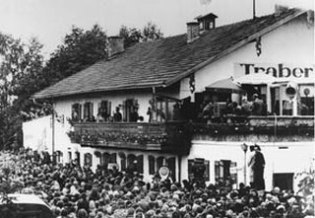The Traberhof ‒ masses of people stream to Rosenheim
Almost 30,000 help-seekers gathered daily before Gröning in September, 1949
 After the investigation in Heidelberg concluded, Bruno Gröning went to South Germany in August, 1949. He wanted to get away from the tumult surrounding his name and withdrew to a private estate near Rosenheim. At first he was able to keep his whereabouts a secret. However, once the first newspapers reported about his arrival in Bavaria, the masses started arriving.
After the investigation in Heidelberg concluded, Bruno Gröning went to South Germany in August, 1949. He wanted to get away from the tumult surrounding his name and withdrew to a private estate near Rosenheim. At first he was able to keep his whereabouts a secret. However, once the first newspapers reported about his arrival in Bavaria, the masses started arriving.
Up to 30,000 people a day streamed to the “Traberhof” in Rosenheim. Press, radio and the weekly news program reported on events. Even a film was made, entitled “Gröning,” documenting the events taking place around him.
Biblical Scenes
In the second week of September, the newspaper Zeitungsblitz reported in a special issue: “Meanwhile, more than 10,000 people had gathered together in the blistering heat for hours, all waiting for the moment when Gröning would appear on the balcony to speak to the masses and radiate his healing energy. The crowd stood densely-packed together, in order to get the full benefit of his ‘healing rays.’ The most seriously ill in their wheelchairs and chairs, or those standing alone at the periphery were already beginning to feel the effects. Half-blind people began to see again, previously disabled people stood up, and paralyzed people began to move their stiffened limbs. Hundreds reported increased pain in the parts of their bodies affected by illness. They reported pulling, prickling sensations and tingling, the feeling of an indescribable ‘lightness of being,’ or of headaches suddenly disappearing.”
Not only at the “Traberhof” were there biblical scenes. Wherever Gröning appeared, he was immediately surrounded by innumerable sick people. Anita Höhne described the situation surrounding Gröning in her book Spiritual Healers Today. Pilgrimages started when Gröning merely announced his impending arrival. Scenes, such as the one journalist Rudolf Spitz observed at a visit of Gröning to Munich in September, 1949, were typical:
“At 7 p.m., thousands were standing in Sonnenstrasse (Sun Street.) At 10:30 p.m., they were still there. During five years of war I had experienced a great deal, but nothing as shattering as in those four hours in which I sat across from Bruno Gröning and experienced a shocking parade of misery and suffering. Epileptics, the blind, lame people on crutches pressed towards him. Mothers held their crippled children out to him. There were unconscious people. Cries rang out, desperate calls for help, pleas, wishes, sighs.”
Government officials recognize goodwill
Anita Höhne quotes the journalist Rudolf Spitz further: “The sick on stretchers, the lame, a huge mass of humanity were observed by another journalist from Munich, Dr Kurt Trampler, who was also at the ‘Traberhof’ in Rosenheim, where Gröning was living. Trampler came there as a reporter for the weekly newspaper Münchner Allgemeine - he was a cool headed journalist, who only recorded what he personally saw and heard. “We hear a voice from the balcony, but not Gröning’s, and hurry towards the window. Pitzer, the president of the Munich police force, speaks to the assembled crowd. He reports that sciatica, which had plagued him for years, has improved in Gröning’s presence. Pitzer is definitely not the sort of man given to hypersensitive imaginings, but can bear witness to that which he observed happen to himself. Here he was openly acknowledging Gröning, and the CSU Politician Hagen followed with a similar statement.”
The Bavarian authorities were also positively inclined toward Bruno Gröning. The daily newspaper Münchner Merkur reported on September 7, 1949, under the title “Goodwill toward Gröning,” “Minister President Dr. Ehard stated at a press conference on Monday, that the work of an exceptional occurence, such as Bruno Gröning, must not be allowed to be squandered because of legalities. In his opinion, no serious obstacles stood in the way of granting Gröning permission to work in Bavaria.”
The Bavarian Ministry for Internal Affairs, had, by copy deadline, announced that the initial examination of Gröning’s healing activities had led to the conclusion that they could be regarded as a free act of love, and as such did not require a permit under the Non-Medical Practitioners Act.
From defamation to medical documentation of the healings
At the Traberhof there a great deal of hustle and bustle around Gröning. There were many business people who wanted to capitalize on his abilities. They damaged his reputation and standing, which resulted in the authorities distancing themselves. When the circumstances became intolerable, Gröning retreated to the mountains of Bavaria. He wanted to look into some of the offers to build healing centers. His goal was to create facilities where help seekers could be healed in an organized way. Doctors would carry out pre- and post-healing examinations along the lines of the Heidelberg model, and document the healings that occurred.




















